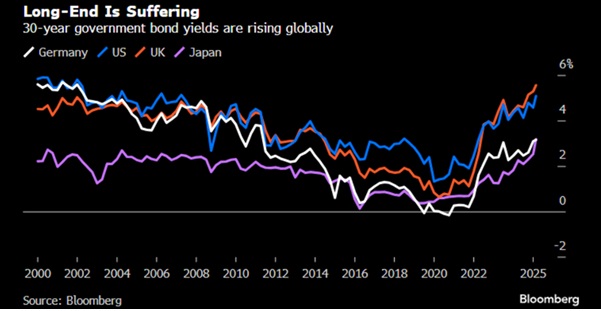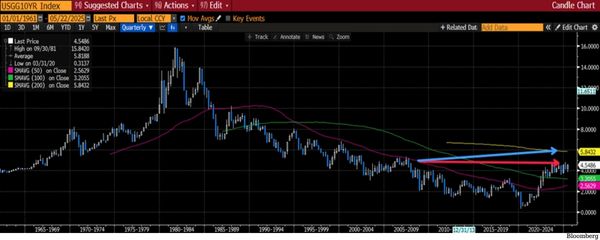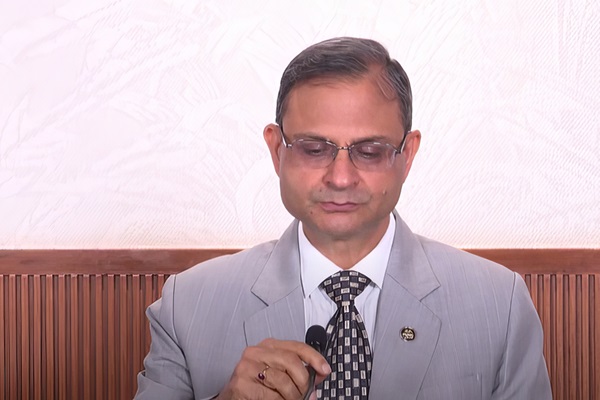.png)
Long(end) Live Bond Vigilantes
Long-end bond yields are surging globally as buyers go on strike—from Tokyo to DC, fiscal largesse and sticky inflation revive bond vigilantes.

By Yield Scribe
Yield Scribe is a bond trader with a macro lens and a habit of writing between trades. He follows cycles, rates, and the long arc of monetary intent.
May 23, 2025 at 6:44 AM IST
What has transpired in global bond markets over the past month is striking not only for the intensity of the move in long-end yields, but also for its breadth.
It began with the Japanese government bond yields surging to multi-decade highs. This was followed by a sharp rise in long-end US Treasury yields, and now eurozone bonds and UK gilts have joined the sell-off.
A common thread runs through all these moves - Bear steepening.
Expectations of persistent inflation, soaring fiscal deficits, and record levels of government spending are some of the underlying forces. But the most significant takeaway is this: long-end bond buyers are on strike across the globe.
Bond vigilantes first reasserted themselves on April 9, when President Donald Trump postponed his reciprocal tariff deadline by 90 days—an early sign that fiscal discipline might be deferred once again. Sensing weakness, they have returned in force.

Thirty-year bond yields in the United States touched 5.15% this week, nearing levels last seen in 2007. In Japan, yields breached record highs in data going back to 1999, with bond auctions in both countries witnessing tepid investor demand.
Bond buyers are citing a host of reasons for their growing reluctance to participate in the long end of the yield curve:
- With the tariff war now postponed, global growth prospects appear firmer, delaying the timeline for rate cuts. In such a scenario, investors see little incentive to absorb the mark-to-market risk associated with holding long-dated bonds.
- Inflation remains stubbornly high, and expectations have become entrenched. Markets have priced in a return to rate cuts on at least eight occasions over the past year—each time prematurely.
- Quantitative tightening by major central banks, combined with a fall-off in pension fund demand, has reduced appetite for long-duration sovereign paper.
- Risk assets continue to rally, with Bitcoin near $108,000 and the S&P 500 hovering around 5,800. Financial conditions remain loose, suggesting that policy is far from restrictive and that inflation could easily reaccelerate.
- Deglobalisation continues to fracture supply chains, contributing to goods inflation and complicating the case for rate cuts.
- Fiscal expansion across major economies has added to long-end supply pressures. Germany is embarking on a fresh spending plan, the United States is advancing new tax cuts, and even in Japan—where inflation is firming—insurers are hesitating to absorb long-dated Japanese government bonds despite their elevated yields.
The precedent is clear. In 2022, former UK Prime Minister Liz Truss faced the wrath of bond markets after unveiling unfunded tax cuts, triggering a gilts rout and ultimately forcing her resignation.
President Trump has already bowed once to market pressure in April. If 10-year US Treasury yields breach the 5% threshold again, the bond vigilantes may claim another political casualty.
In Japan, the challenge lies with a central bank seemingly caught in a time warp—unable to clearly signal whether it intends to raise interest rates. This policy ambiguity has contributed to a buyers' strike at the long end of the JGB curve.
With national elections looming and talk of yet another round of tax cuts gaining ground, it is increasingly likely that Japanese government bond yields will have to rise considerably further before domestic insurers and pension funds deem them attractive.
A key inflection point may come at the 40-year Japanese government bond auction scheduled for May 28. The outcome could prove a litmus test for the Ministry of Finance—and, if weak, a signal of further yield pressure to come.
The United States faces similar headwinds. A straightforward fiscal arithmetic suggests that the newly-passed budget bill will add $200 billion to $300 billion to the existing annual deficit of $1.8 trillion. It is unlikely that Treasury Secretary Scott Bessent can sustain current coupon issuance patterns beyond February 2026 without adjustment.
The Treasury Department will be forced either to increase short-dated issuance above the current 23% share or to expand coupon supply.
At the heart of today’s yield dynamics lies a deeper structural interlinkage: long-end US Treasuries and Japanese bonds are now effectively tethered. Japan holds $1.2 trillion in US Treasuries. The more pressure JGBs face, the greater the knock-on effect on US debt markets.
At some point, local insurance players will find 30-year Japanese bonds compelling. When that threshold is crossed, it could trigger a significant repricing across global bond and currency markets.
If Japanese government bond yields rise another 50 basis points, the yen could fall below 140 against the US dollar and potentially cascade toward 130. Such a sharp depreciation would likely trigger outflows from global risk assets, including emerging market equities and US Treasuries.
The greater concern, however, is not just yen weakness but the risk of an abrupt reversal. A sudden bout of yen strength could force underhedged foreign investors to repatriate capital quickly—particularly if domestic Japanese investors begin shifting into long-dated government bonds.
Currently, 30-year Japanese government bonds, when hedged for currency risk, yield approximately 4.65%, factoring in a 1.5% annualised hedging cost. This is approaching the 5.1% yield on comparable US Treasuries, and the gap continues to narrow.
Exacerbating the vulnerability is a shift in how the dollar index behaves during periods of risk aversion. In contrast to the pre-Trump era, when rising US yields typically supported the dollar, the index now tends to weaken. This inversion reflects a deeper shift in perception: US Treasuries are increasingly seen as behaving like emerging market assets, especially for investors holding unhedged positions.
We are exiting a four-decade era of low inflation and high productivity, and entering one defined by sticky inflation and muted productivity growth—despite high expectations for artificial intelligence, which remains unproven at scale.
In this new regime, long-end bond investors are demanding greater compensation for both duration and inflation risk. The adjustment is far from over. It will likely worsen before stability returns.
Markets should brace for a potential multi-year breakout in the 10-year US Treasury yield—more structural than cyclical in nature.








